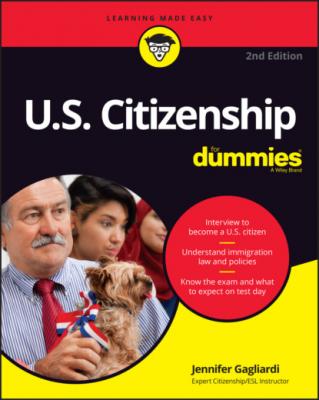ТОП просматриваемых книг сайта:
U.S. Citizenship For Dummies. Jennifer Gagliardi
Читать онлайн.Название U.S. Citizenship For Dummies
Год выпуска 0
isbn 9781119766896
Автор произведения Jennifer Gagliardi
Издательство John Wiley & Sons Limited
Determining whether you need a visa
You may not need a visa to enter the United States if you’re entering under NAFTA or the Visa Waiver Program (VWP). The VWP allows foreign nationals from certain designated countries to enter the United States as nonimmigrants for business or pleasure under limited conditions, and for no more than 90 days, without first obtaining a nonimmigrant visa.
MARRYING INTO THE UNITED STATES
In order for a U.S. citizen to bring their foreign-born fiancé(e) to the United States, the citizen must file a Form I-129F with the U.S. Citizenship and Immigration Services (USCIS). See Visas for Fiancé(e)s of U.S. Citizens at www.uscis.gov/family/family-of-us-citizens/visas-for-fiancees-of-us-citizens. After the form is approved, USCIS forwards the petition to the relevant U.S. embassy or consulate abroad. The embassy or consulate then contacts the fiancé(e) to schedule a visa interview. The U.S. citizen and their foreign-born fiancé(e) must marry within 90 days from the day the fiancé(e) enters the country.
If you have already married, plan to marry outside the United States, or your fiancé(e) is already residing legally in the United States, your spouse or fiancé(e) is not eligible for a fiancé(e) visa. Go to the Bringing Spouses to Live in the United States as Permanent Residents web page for more information about how to help your foreign spouse apply for a green card (www.uscis.gov/family/bring-spouse-to-live-in-US).
You and your fiancé(e) may be romantics, but the USCIS is not. They don’t automatically assume you will actually marry. After the wedding, the U.S. citizen must again contact the USCIS to change their spouse’s immigration status from nonimmigrant to lawful permanent resident.
The U.S. government believes that the countries accepted in the VWP are not likely to compromise U.S. law-enforcement or national-security interests — including the enforcement of immigration laws. Countries can be added or deleted from the program at any time, so be sure to consult the U.S. Department of State for the latest information (go to https://travel.state.gov/content/travel/en/us-visas/tourism-visit/visa-waiver-program.html for information). There are over 40 countries on the Visa Waiver Program list, including most European countries, Australia, Brunei, Chile, Japan, New Zealand, Singapore, South Korea, and Taiwan. Although not specifically listed as a Visa Waiver country, Canada’s citizens and landed immigrants also can enter the Untied States for business or pleasure without visas.
https://esta.cbp.dhs.gov/esta).
Discovering the common types of nonimmigrant visas
Most nonimmigrants in the United States fall under the categories of business or pleasure visitors:
Business visitors: The B-1 nonimmigrant category includes those coming to the United States to conduct business with a company here. Activities include consultation, negotiating a contract, and participating in short-term training. This type of visa does not allow the visitor to hold a job or work for pay in the United States. See B-1 Temporary Business Visitor at www.uscis.gov/working-in-the-united-states/temporary-visitors-for-business/b-1-temporary-business-visitor.
Pleasure visitors: The B-2 nonimmigrant category includes those visiting the United States for the pure enjoyment of the many attractions this country has to offer. It also includes those who come to this country for a number of other purposes, including seeking medical treatment. In our experience, most medical treatments are hardly pleasurable, but nonetheless, the government lumps them into the same category as pleasure visitors. See Tourism (B-2) at travel.state.gov/content/travel/en/us-visas/tourism-visit/visitor.html.
The Visa Wizard is an online tool to help foreign citizens understand which visa category may be appropriate for their travel to the United States. See the Visa Wizard at travel.state.gov/content/travel/en/us-visas/visa-information-resources/wizard.html.
The results from this Visa Wizard do not guarantee that you will be eligible under law to receive a visa. You must meet all legal requirements of the visa for which you are applying. The consular officer at the U.S. Embassy or Consulate where you apply will determine your visa eligibility and the visa category suitable for your purpose of travel, based on U.S. immigration law.
Note: The Visa Wizard includes the most common visas but does not include every visa.
Students, temporary workers, crewmen, journalists, and all others planning to travel to the United States for a purpose other than business or pleasure must apply in a different visa category. The State Department issues a huge range of visas for all different types of circumstances. For additional detailed information about your unique visa needs, consult the State Department website (travel.state.gov/content/travel/en/us-visas.html).
Changing or adjusting your nonimmigrant status
Certain individuals who are already legally in the country may qualify to change or adjust their immigration statuses. They may be eligible to change from one category of nonimmigrant status to another or may even have the opportunity to adjust from nonimmigrant to lawful permanent resident status.
A problem may occur while the noncitizen spouse is waiting for the adjustment of status petition to be processed. If the noncitizen spouse overstays the original visa, they are “out-of-status” and are unlawfully residing in the United States. Therefore, the noncitizen spouse is not eligible for adjustment of status. Upon leaving the United States after having been unlawfully present for more than 180 days or a year, the noncitizen

